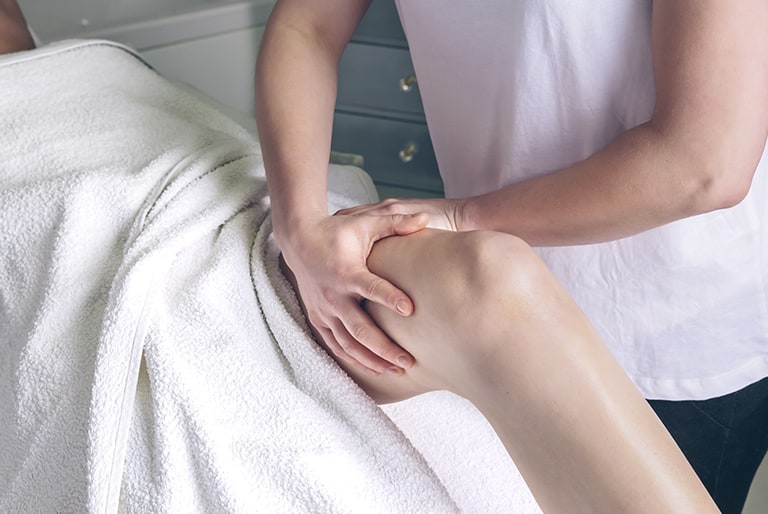Treating water retention
Your skin tightens, your socks cut in, your clothes fit tighter and somehow your legs feel heavy and lethargic. There can be many reasons for water retention in tissue, all of which can usually be easily treated. You can learn here how oedemas develop and which possible treatments there are.

How does too much water build up in your body?
Possible reasons for water retention:
- Long periods seated or standing: it is usually your legs which get affected by water retention. The reason is that gravity naturally pulls liquids downwards. If the water cannot then be sufficiently transported upwards from your feet and legs, swelling and oedemas develop.
- Heat in summer: your body can dehydrate very quickly in summer due to heavy perspiration. Your body then stores emergency reserves of water in your tissue. Your vessels also expand due to the heat and facilitate the formation of oedemas.
- Hormonal changes: the menstrual cycle, a pregnancy or the menopause can cause changes in the hormonal balance which collects water in tissue.
- Nutrition: too much salt in your food, too many ready meals, too much alcohol, too much coffee and too little fluids in the form of water or tea all disrupt the fluid balance.
- Diseases: oedemas in your legs could hide diseases such as venous insufficiency, heart failure, renal insufficiency, thyroid problems or lymphatic system disorders.
- Medicines: the regular taking of medicines can also be a cause for water retention. Usually, the oedemas improve when the medication is stopped, which should only be done after consultation with your doctor.
Quite often the water retention is in your extremities. It can also appear in your face or your stomach. Consult a doctor if you often suffer from oedemas, in order to investigate their cause and to find a suitable therapy.
How can I treat water retention in my legs?
The possible treatments are as diverse as the causes. Some household remedies are generally helpful with reducing excess water in your body. Sometimes, though, treatment with medicines is necessary:
- Movement: lots of movement is the key to keeping your blood in motion and to supporting the removal of fluids from your legs. Because the movement when running, cycling or walking up stairs is required by leg muscles, which in turn start the muscle pump, without which our veins cannot convey any blood upwards towards the heart. Sitting and standing, on the contrary, promote the development of water retention and should be strongly compensated by regular movement exercises.
- Nutrition: salt promotes water retention in tissue and should only be used sparingly. Since ready meals usually contain a lot of salt, you should completely avoid processed foods, and rather eat lots of fresh fruit and vegetables. Fresh herbs and spices without salt are ideal for seasoning food. In addition to that, there are some foodstuffs which are particularly good at reducing excess water, e.g. cucumbers, pineapples, asparagus or strawberries.
- Tea: various herbs have a diuretic effect and can help natural water reduction when drunk as a tea. Birch leaf, dandelion, nettle and green teas are especially effective.
- Drinking: it is important to consume sufficient fluids in order to reduce excess water in your legs, so that your blood can circulate properly. If you do not drink enough, your body will switch to economy mode and will store in your tissue the small amount of fluids which it has available, for the bad times ahead.
- Put your feet up: your blood vessels expand after a hot summer’s day and directly invite water to collect there. Putting your feet up can help support the outflow and quickly reduce swelling.
- Cold shower: rinsing with cold water causes your blood vessels to contract and your circulation to be stimulated. Contrast showers as a daily ritual help against water retention.
- Compression: compression bandages or stockings put external pressure on the vessels in your legs, which presses the vein walls closer together and your blood flow functions better. Also, wearing compression stockings prevents the development of oedemas.
- Lymphatic drainage: if the water retention is as a result of an operation, a lymphoedema or a lipoedema, then lymphatic drainage is a useful method for stimulating lymph circulation and for removing water from your tissue.
- Medicines: on the one hand, water in your legs can be treated with diuretics, which remove water from your body. On the other, it is possible to have a therapy with oedema protective agents, which counteract the formation of oedemas and improve your blood flow. Troxerutin, contained in Veno SL® 300, is one of the active ingredients which are used for the supportive treatment of fluid retention in tissue and which support the health of veins.
Can oedemas be cured?
An oedema is not an illness, but rather a symptom, and forms in your body as the consequence of another defective function. Once the source for the formation of water retention has been found and treated, the oedemas normally disappear again. That is why swellings on your legs or on other parts of your body should be taken seriously, as they can mask an underlying health problem. You should definitely consult a doctor if you also have associated pain.



